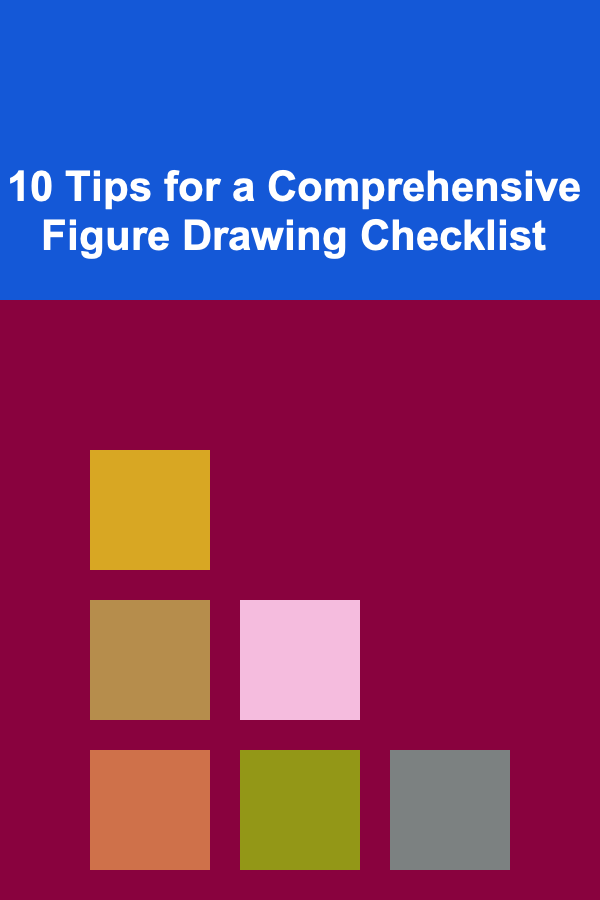
10 Tips for a Comprehensive Figure Drawing Checklist
ebook include PDF & Audio bundle (Micro Guide)
$12.99$6.99
Limited Time Offer! Order within the next:

Figure drawing is an essential practice for artists who wish to understand human anatomy, improve their artistic skills, and enhance their ability to capture the human form in a realistic or stylized manner. Whether you're a beginner learning the fundamentals or an advanced artist refining your craft, having a clear and organized approach to figure drawing can significantly improve your results.
A comprehensive checklist for figure drawing can help you streamline your workflow, ensuring that each drawing session is productive, purposeful, and effective. This checklist goes beyond simply sketching the body; it addresses anatomical accuracy, proportions, dynamic poses, and artistic style, among other key factors. By using this guide, you will develop a stronger understanding of how to approach figure drawing with confidence and precision.
Here, we'll explore 10 essential tips that should be included in a comprehensive figure drawing checklist. These tips will serve as a roadmap for your figure drawing practice, enhancing both your technical skills and artistic expression.
Start with Gesture Drawing
Gesture drawing is a fundamental technique that helps capture the essence of a pose. The purpose of gesture drawing is to convey the motion, flow, and energy of the human body rather than focusing on intricate details. It's a quick, fluid process that helps you loosen up and approach the figure with an intuitive understanding of its form.
When starting a figure drawing session, it's essential to begin with several short, timed gesture sketches. These drawings should focus on the overall action and posture of the figure. Don't worry about accuracy or fine details at this stage; instead, aim for expressive lines that suggest movement and balance.
Key Actions:
- Use short time limits (1-5 minutes) for each gesture drawing.
- Focus on capturing the energy and movement of the pose rather than details.
- Start with simple lines and shapes to represent the figure's posture.
Analyze Proportions and Scale
Understanding human proportions is critical to creating believable figure drawings. The ideal proportions of the human body serve as a framework for your drawing, guiding the placement of limbs, head, torso, and other features. The most commonly referenced guideline is that the human body is about 7.5 to 8 heads tall. However, variations exist, particularly with regard to different body types, ages, and ethnicities.
Before you start adding details, spend time studying the proportions of the figure. The head, for example, is often used as a unit of measurement to help scale the body accurately. Knowing where to place key landmarks like the shoulders, hips, and knees will allow you to structure your drawing more accurately.
Key Actions:
- Use the "head count" method to gauge the overall height of the body.
- Break down the body into basic sections (e.g., torso, legs, arms) to keep proportions accurate.
- Pay attention to unique variations in proportions based on the model's age, body type, and gender.
Establish a Solid Skeleton Framework
Before fleshing out muscles and skin, it's crucial to establish the underlying skeletal structure of the figure. The skeleton serves as the foundation for the body, and understanding how bones connect and interact will allow you to create more realistic poses.
Start by lightly sketching the basic shapes that represent the rib cage, pelvis, spine, arms, and legs. The rib cage, for example, can be represented by a simplified oval, and the pelvis can be depicted as a bowl-like shape. You can also draw the centerline of the body (spine) to help you understand the posture and alignment.
Key Actions:
- Use simple lines and shapes to represent the skeleton's major components (head, torso, arms, legs, etc.).
- Draw the spine as a curved line to depict posture and movement.
- Map out joints and their range of motion, particularly around the shoulders, hips, elbows, and knees.
Study Anatomy and Muscle Groups
While a basic skeleton gives structure, muscles define the contours of the body and add volume. Understanding the muscles' locations and functions will enhance your figure drawings, allowing you to depict realistic movement and tension.
Study the major muscle groups and their roles in various poses. For example, the deltoids and biceps are prominent in arm movements, while the quadriceps and hamstrings dominate leg movement. You don't need to memorize every muscle, but understanding the basic muscle groups and their functions will help you add believability to your figures.
Key Actions:
- Study reference materials like anatomy books, online resources, or anatomical mannequins.
- Focus on major muscle groups (e.g., deltoids, pectorals, abdominals, quadriceps).
- Incorporate the changes in muscle definition based on the pose and movement of the figure.
Focus on Line of Action and Balance
The line of action is an imaginary line that runs through the body and indicates the figure's dynamic energy. It is the path that guides the flow of motion, from the head through the spine and into the limbs. A strong line of action helps prevent stiff, unnatural poses and instead creates fluidity and grace.
When drawing the human figure, always keep the line of action in mind, especially when working with dynamic poses. The line will influence the balance of the figure, helping you establish a more natural and engaging drawing.
Key Actions:
- Draw the line of action before adding details to the figure.
- Ensure the line of action reflects the natural flow of movement.
- Pay attention to balance by checking how the weight of the body is distributed between the feet or supporting limbs.
Use Simplified Shapes for Volume
Rather than diving straight into intricate details, break down the figure into simplified geometric shapes (spheres, cylinders, boxes) to represent major body parts. For example, the torso can be thought of as a box, the arms as cylinders, and the legs as elongated ovals or cones.
These simplified shapes will allow you to understand the three-dimensional structure of the body and will help you make better decisions when it comes to foreshortening, depth, and perspective. As you refine your drawing, you can add muscle structure and skin over the basic shapes.
Key Actions:
- Start with basic geometric shapes to define the body's volume.
- Focus on representing the three-dimensional nature of the figure.
- Gradually add more detail as you refine the drawing.
Pay Attention to Lighting and Shadows
Lighting and shadow play a critical role in adding depth and realism to figure drawings. They help define the three-dimensional form of the figure, create emphasis, and add dramatic effects. Understanding how light interacts with the body is crucial for creating believable figures that don't look flat.
Study how light affects different parts of the body, especially in relation to the bone structure and muscle contours. Notice how shadows fall on the figure's torso, limbs, and face. Shadows tend to be darker on the side of the body opposite the light source and softer on the areas where the light hits directly.
Key Actions:
- Determine your light source and ensure that the shadows are consistent with it.
- Observe how light creates volume and depth on the figure.
- Use both soft and hard shadows to add contrast and dimension to your drawing.
Experiment with Perspective and Foreshortening
Foreshortening is the technique of depicting an object or figure in perspective, making it appear shorter than it is in reality due to its angle to the viewer. For example, when a figure is viewed from a low angle, the legs may appear longer and more elongated, while the torso may seem compressed.
Foreshortening is one of the more challenging aspects of figure drawing, but it's essential for creating dynamic, lifelike compositions. To master foreshortening, practice drawing figures from extreme perspectives, such as low or high angles, to understand how to manipulate shapes in perspective.
Key Actions:
- Practice drawing figures from different angles, especially from above or below.
- Use perspective lines to help guide the accurate proportions of foreshortened limbs.
- Be mindful of the effect of perspective on the body's volume and proportions.
Refine Details and Textures
Once the basic structure, pose, and anatomy are established, it's time to refine the figure by adding smaller details such as facial features, skin texture, clothing, and hair. Depending on your style, you may choose to focus on fine details or emphasize larger gestures and shapes instead.
When adding texture, remember that the human body has a variety of surfaces, from the smoothness of the skin to the coarseness of hair and fabric. Use different techniques to capture these textures---cross-hatching for shadowed areas, delicate lines for hair, or light, sweeping strokes for skin texture.
Key Actions:
- Add details gradually, starting from the most important areas (e.g., face, hands).
- Experiment with various techniques to create different textures (e.g., hair, skin, fabric).
- Keep your drawing balanced between details and the broader flow of the figure.
Final Check and Adjustments
After completing the figure drawing, take time to step back and evaluate the overall composition. Check the proportions, alignment, and balance of the figure. Look for any areas that may need refining, such as the consistency of shadows or the accuracy of muscle definitions.
This step is crucial because small adjustments can make a big difference in improving the overall look of your drawing. Don't hesitate to erase or modify parts of your drawing until you are satisfied with the result.
Key Actions:
- Step back from your drawing and analyze the overall composition.
- Check the proportions and ensure that the figure appears balanced and natural.
- Make final adjustments to improve accuracy, shading, or texture.
Conclusion
Figure drawing is a complex but rewarding discipline that requires practice, patience, and a comprehensive approach. By following these 10 tips and creating a structured checklist, you can break down the process into manageable steps that will enhance your understanding of anatomy, proportion, perspective, and lighting.
Each tip is designed to help you develop a holistic view of the human figure, moving from simple gestures and structure to refined details and textures. By consistently incorporating these principles into your figure drawing practice, you'll not only improve your technical skills but also develop a deeper appreciation for the beauty and complexity of the human form.
Reading More From Our Other Websites
- [Polymer Clay Modeling Tip 101] Step-by-Step Techniques for Creating Intricate Caned Patterns
- [Home Budget 101] How to Stick to Your Home Budget During Holidays and Special Occasions
- [Personal Investment 101] How to Create a Financial Plan That Supports Your Investment Goals
- [Organization Tip 101] How to Research and Choose the Right Wedding Officiant
- [Home Party Planning 101] How to Plan a Virtual Escape Room Party for Friends
- [Home Rental Property 101] How to Choose the Right Insurance for Your Rental Property
- [Organization Tip 101] How to Keep Your Beauty Area Tidy with Regular Cleanouts
- [Tie-Dyeing Tip 101] DIY String Tie-Dye Hacks: Transform Everyday Materials into Colorful Masterpieces
- [Personal Investment 101] How to Profit from Deep Learning Models in the E-commerce Industry
- [Personal Care Tips 101] How to Apply Makeup Primer for Oily Skin

How to Achieve a Modern Look on a Budget
Read More
How To Implement Direct Mail Marketing
Read More
How to Light Your Home for the Holidays with Budget-Friendly Ideas
Read More
How to Prevent Property Damage by Tenants
Read More
The Art of Time Management: How to Stand Out by Making the Most of Your Day
Read More
How to Design Accessible Urban Spaces
Read MoreOther Products

How to Achieve a Modern Look on a Budget
Read More
How To Implement Direct Mail Marketing
Read More
How to Light Your Home for the Holidays with Budget-Friendly Ideas
Read More
How to Prevent Property Damage by Tenants
Read More
The Art of Time Management: How to Stand Out by Making the Most of Your Day
Read More